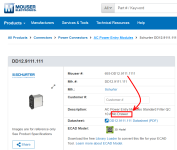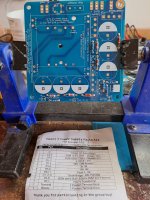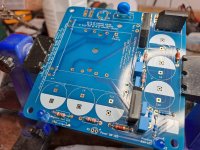DD12.9111.1111 is indeed without fuse drawer. Guess how I know 😜.
Yes there are! I will switch them off and see what happens...Been selling audio for over 40 years and this is a very unusual problem, are there any routers, modems, repeaters etc. near the system?
Thanks
Thanks but no dc at the outputCould it be, that you have a tiny DC on output, and your preamp actually shorts/grounds the unselected inputs?
Bullseye!!! For tv and streaming I use a network connection over the 230 AC power network. Took that adapter out of the power grid et voilà nomore clicks and pops. And now the Pearl3 plays very nice indeed. Thank you so much!Been selling audio for over 40 years and this is a very unusual problem, are there any routers, modems, repeaters etc. near the system?
@Lvandoorn, not having the technical chops I am so happy to be able to give back to this incredible community! Thank you 🙂
And now even the problem of the on and off turning of the red leds has disappeared.... In Dutch for this kind of big surprises we say, translated: Now breaks my wooden shoe. So this network connection over the grid really brings a lot of garbage in the power grid and the room. As could have been expected of course, pfff. Onwards to other solutions for my network! My gratitude to Toys4Boys is of course even greater now. And what a nice place this forum is for people with different skill levels and knowhow but a shared interest in good music reproduction
So odd! Ground loops, RFI, EMI oh my, so many ways noise can enter the audio chain, not to mention how it manifests.And now even the problem of the on and off turning of the red leds has disappeared
I'm tempted to ask what in the P3 is being effected and how, but the explanation would likely make my head explode.
Just waiting on a fuse drawer. I had ordered the DD12.9111.1111 PEM from Mouser and it arrived without the fuse drawer. Let them know it was missing and they said it is not included and I had to order it separately so I did. Seems odd, I did not see any mention of it in the description?
Mouser put it in the description, but I guess it's easy to overlook.
_
Attachments
So odd! Ground loops, RFI, EMI oh my, so many ways noise can enter the audio chain, not to mention how it manifests.
I'm tempted to ask what in the P3 is being effected and how, but the explanation would likely make my head explode.
It's not a hard explanation at all.. the phonostage has 70db of gain. (And actually, the total open-loop gain is a whole lot more...)
70db is a gain of 3000x
So whatever noise and junk the various components and devices are spitting out, the phonostage is making it 3000x bigger. It gets amplified.
And now even the problem of the on and off turning of the red leds has disappeared.... In Dutch for this kind of big surprises we say, translated: Now breaks my wooden shoe
This is surprising, but it is fantastic news.
@Lvandoorn When you have a chance, do make sure that you have good electrical connection from every panel of chassis to each other, including PSU... This ensures electrical shield, and will help mitigate this. You likely have to make a point to remove paint and anodization.
I really appreciate the detailed documentation, Wayne’s design and proven PCBs, the build guides, and prefab Modushop enclosures for a small signal project like this. Every element—including how you dress your wire runs, not making good electrical contact at the enclosure edges, etc, can
Hats off to Wayne, 6L6, rhthatcher, and anyone else I have missed who put this together. If you are having trouble, you cannot get better online support than this group. Don’t be afraid to ask. Sharpest eyes on the planet in this forum.
The small-signal stuff (phono preamps, condenser microphones, even high-gain guitar amps) can be surprisingly fiddly. I followed the documentation down to mimicking the lead dress and am thrilled with the result—still had to troubleshoot my scraping the powder coat for continuity and had a boneheaded issue with my umbilical cable.So odd! Ground loops, RFI, EMI oh my, so many ways noise can enter the audio chain, not to mention how it manifests.
I'm tempted to ask what in the P3 is being effected and how, but the explanation would likely make my head explode.
Hats off to Wayne, 6L6, rhthatcher, and anyone else I have missed who put this together. If you are having trouble, you cannot get better online support than this group. Don’t be afraid to ask. Sharpest eyes on the planet in this forum.
@Lvandoorn When you have a chance, do make sure that you have good electrical connection from every panel of chassis to each other, including PSU... This ensures electrical shield, and will help mitigate this. You likely have to make a point to remove paint and anodization.
Thanks, but I really made an effort in sanding relevant spots down to naked alu or iron with a power tool. And measured the resistance for all panels... Faraday would be proud..
Thanks, but I really made an effort in sanding relevant spots down to naked alu or iron with a power tool. And measured the resistance for all panels... Faraday would be proud..
Also pay attention to the RCA input connections.
Short the RCA inputs and watch the noise disappear.
Thanks DT
Short the RCA inputs and watch the noise disappear.
Thanks DT
Good! Nicely done. 🙂
Although we try to shield everyting as best as possible, the cartridge, tonearm wiring, interconnects, etc… all can and do act as an antenna, and the interference (which can be a very large signal!) gets sent down the line, and then amplified.
As @DualTriode mentions, shorting the inputs (disconnecting the turntable and using an RCA plug with barrel and pin connected) would stop this from happening, of course, as the wiring “antenna” would be removed and the Pearl 3 input would see nothing but ground, which is quiet. The disadvantage of shorting the input is you need to select another source other than LP if you want to listen to music…
Although we try to shield everyting as best as possible, the cartridge, tonearm wiring, interconnects, etc… all can and do act as an antenna, and the interference (which can be a very large signal!) gets sent down the line, and then amplified.
As @DualTriode mentions, shorting the inputs (disconnecting the turntable and using an RCA plug with barrel and pin connected) would stop this from happening, of course, as the wiring “antenna” would be removed and the Pearl 3 input would see nothing but ground, which is quiet. The disadvantage of shorting the input is you need to select another source other than LP if you want to listen to music…
Okay, I'm not clear, my assumption was that @DualTriode was referring to a P3 using balanced?As @DualTriode mentions, shorting the inputs (disconnecting the turntable and using an RCA plug with barrel and pin connected) would stop this from happening, of course, as the wiring “antenna” would be removed and the Pearl 3 input would see nothing but ground, which is quiet. The disadvantage of shorting the input is you need to select another source other than LP if you want to listen to music…
Okay, I'm not clear, my assumption was that @DualTriode was referring to a P3 using balanced?
Well, no, as the Balanced connection is only output.
D'Oh! So an exercise to determine potential noise?Well, no, as the Balanced connection is only output.
So today I finished the second channel. This time with R1 = 383R. Now voltages around Q5 are as they should be (with my rather high Idss 2SK170's). As with the other channel 777R for R27 gives 4mA bias. This channel is also making music, bit of hum with ear to the speaker as with the other channel (as they are completely unshielded). To my ear a bit less hiss, this may be due to higher voltages for the input jfets. I have changed R1 in the other channel to 383R as well, and voltages there are now also as they should be.
- Home
- Amplifiers
- Pass Labs
- Pearl 3 Burning Amp 2023



